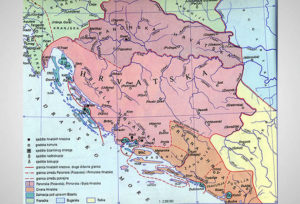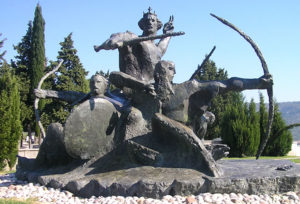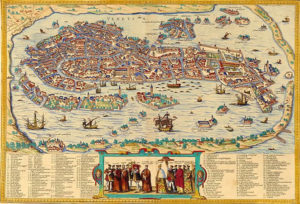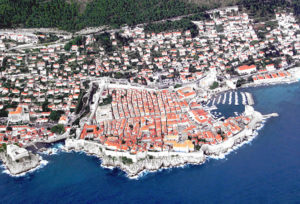 Duke Domagoj came to the throne around 864 and stayed there until 876. His rule differred in many things from the one of his predecessor. Even until today, no churches built by Domagoj nor any stone inscription with his name has been found in the archaeological research.1 The lack of material evidence does not mean, however, that the process of christianization in Croatia has been stopped. Don’t Domagoj’s commitment to banishment of Saracens from Bari and the glory he gained in the Christian world, as well as the relationship the Pope had towards him (John VIII (872-882) nicknames him „the glorious duke“), speak plenty of his religious and political views?
Duke Domagoj came to the throne around 864 and stayed there until 876. His rule differred in many things from the one of his predecessor. Even until today, no churches built by Domagoj nor any stone inscription with his name has been found in the archaeological research.1 The lack of material evidence does not mean, however, that the process of christianization in Croatia has been stopped. Don’t Domagoj’s commitment to banishment of Saracens from Bari and the glory he gained in the Christian world, as well as the relationship the Pope had towards him (John VIII (872-882) nicknames him „the glorious duke“), speak plenty of his religious and political views?
The Venetians planned to exploit the inner tensions and turmoils on the throne to their benefit. Domagoj, being wise, seeing he wouldn’t be able to resist the Venetian force, asked for a truce, which the doge Orso I Participazio accepted, taking hostages.2 At that time, Francia and Byzantium were more and more facing the large and increasing Arabian threat. Arabian raids on the maritime Christian estates were getting ever so frequent. In 866, they penetrated the Adriatic sea and started the siege of Dubrovnik. The people of Dubrovnik have sent an appeal for help to Byzantium, now lead by Basil I (867-886), whose main goal was to restore the dignity and power to the stumbling Empire. Basil responded and helped break the siege, which meant a firm decision on restoring Byzantine authority over Dalmatian cities. With this as a target, he turned Dalmatia into a specially organized military region, the so-called „them“, with a military Strategion in charge, residing in Zadar.
 At the same time as these events took place in the Eastern shore of the Adratic sea, the Western shore was undergoing a great military campaign in the south by Franks, led by Louis II (855-875), started by the siege of Bari, which was a very important harbour, that was already in Arabian possession for some time, in 869. Even though Basil promised to send his military navy to block the Bari harbor, he failed to do so. Instead, Louis II called upon his vassal Domagoj’s military navy. By combined efforts, Louis and Domagoj were able to free the city and on February 2nd, 871 they marched into it triumphantly. Basil „used“ this military campaign by sending his military fleet to pillage Croatian coastal region. However, despite this action, Basil was not able to return his candidate, Zdeslav, who was son of Trpimir who escaped from Croatia and Domagoj, finding shelter in Constantinople, to the Croatian throne.3 This Basil’s act caused disbelief and bitterness, not only in Domagoj, but also in pope Hadrian II (867-872) and emperor Louis II. These two sent letters of protest to Basil demanding that he returned the prisoners and loot to Domagoj, but since this hasn’t happened, Domagoj went to open war against Byzantium – more precisely against the Byzantine vassals on the Adriatic, Venice. 4
At the same time as these events took place in the Eastern shore of the Adratic sea, the Western shore was undergoing a great military campaign in the south by Franks, led by Louis II (855-875), started by the siege of Bari, which was a very important harbour, that was already in Arabian possession for some time, in 869. Even though Basil promised to send his military navy to block the Bari harbor, he failed to do so. Instead, Louis II called upon his vassal Domagoj’s military navy. By combined efforts, Louis and Domagoj were able to free the city and on February 2nd, 871 they marched into it triumphantly. Basil „used“ this military campaign by sending his military fleet to pillage Croatian coastal region. However, despite this action, Basil was not able to return his candidate, Zdeslav, who was son of Trpimir who escaped from Croatia and Domagoj, finding shelter in Constantinople, to the Croatian throne.3 This Basil’s act caused disbelief and bitterness, not only in Domagoj, but also in pope Hadrian II (867-872) and emperor Louis II. These two sent letters of protest to Basil demanding that he returned the prisoners and loot to Domagoj, but since this hasn’t happened, Domagoj went to open war against Byzantium – more precisely against the Byzantine vassals on the Adriatic, Venice. 4
 That was the start of the hardest period in medieval history of Venice. Croatian navy was ruthless in intercepting, plundering and destroying Venetian merchant ships from 871 to the appointment of Zdeslav to the throne in 878. The government authorities have persistently been trying to negotiate a peace treaty with Venice through Rome. For example, pope John VIII tried to warn Domagoj, in a letter he advised him to stop „pirates“ from looting Christian vessels, but without success. Thus, it would seem that Venetian chronicler John the Deacon has with every right assessed the time of Domagoj’s reign to be the reign of „the worst duke of all the Slavs“ (pessimus Sclavorum dux).5
That was the start of the hardest period in medieval history of Venice. Croatian navy was ruthless in intercepting, plundering and destroying Venetian merchant ships from 871 to the appointment of Zdeslav to the throne in 878. The government authorities have persistently been trying to negotiate a peace treaty with Venice through Rome. For example, pope John VIII tried to warn Domagoj, in a letter he advised him to stop „pirates“ from looting Christian vessels, but without success. Thus, it would seem that Venetian chronicler John the Deacon has with every right assessed the time of Domagoj’s reign to be the reign of „the worst duke of all the Slavs“ (pessimus Sclavorum dux).5
Another thing we learn from the forementioned pope John VIII’s letter to the duke of Croatia is the existence of a plot against Domagoj in 874. The pope who, like his predecessor, addresses him as a glorious duke, pleads him to spare the lives of conspirators henceforward. In fact, Domagoj didn’t just order the conspirators to be execeuted, but also the man who tipped him off. 6
Emperor Louis II died in 875 and was succeeded by Charles II (875-877). Venetians were finally able to make a deal of cooperation with him, hoping that they will be able to force Domagoj to withdraw and stop the military operations. But, Domagoj reacted rather unexpectedly. He attacked Frankish territories on the Adriatic – he pillaged Histrian towns of Umag, Novigrad, Sipar and Rovinj with the „worst nations of Slavs and Dalmatians“, much to everyone’s surprise. 7 So, according to chronicler John the Deacon, this was an „allied“ action of both Croats and Dalmatians, which confirms that Domagoj controlled the Dalmatian cities as well. At that time, one of his flotillas set off for Gradež as well, but doge Urso cut off the attack; according to the chronicler, he violently attacked the Croats with 30 ships, and defeated them. The troubles of Venetians and Histrians ended only after the death of Domagoj.8
 Domagoj died in 876, and the duke’s throne was shortly occupied by one of his heirs.9 As soon as 878, Zdeslav, Trpimir’s son, sat on the duke’s throne; he managed, with the help from Byzantium, to exile Domagoj’s heirs.10 Basil I succeeded in the attempt to appoint his favorite to Croatian throne, and hence claim governance over Dalmatian cities and their background once again. By a cunning move he prevented any possible Slavenic attacks, by declaring that Dalmatian cities should pay their annual taxes to the Duke of Croatia, Zahum and Travunj instead of the Strategion in Zadar. By reforming the ecclesiastical organization, the emperor subordinated the Dalmatian bishops, who were until under jurisdiction of the Pope, to the Patriarch of Constantinople.11
Domagoj died in 876, and the duke’s throne was shortly occupied by one of his heirs.9 As soon as 878, Zdeslav, Trpimir’s son, sat on the duke’s throne; he managed, with the help from Byzantium, to exile Domagoj’s heirs.10 Basil I succeeded in the attempt to appoint his favorite to Croatian throne, and hence claim governance over Dalmatian cities and their background once again. By a cunning move he prevented any possible Slavenic attacks, by declaring that Dalmatian cities should pay their annual taxes to the Duke of Croatia, Zahum and Travunj instead of the Strategion in Zadar. By reforming the ecclesiastical organization, the emperor subordinated the Dalmatian bishops, who were until under jurisdiction of the Pope, to the Patriarch of Constantinople.11
However, Zdeslav’s reign was brief. The Croats obviously couldn’t deal with the pro-Byzantine politics of Zdeslav and complete dependency on Byzantium and Venice, with whom they had dealt so successfully over the years, and finally managed to achieve complete independence, even in relation to Francia. Hence, only after a year after Zdeslav’s appointment to the throne, to his great disappointment pious Venetian chronicler John the Deacon was anxiously forced to write down that „some Slav by the name of Branimir, by murdering Zdeslav, took claim of his duchy“.12
Other articles from the series: “The Trpimirović Dynasty of Croatian Rulers”
- From the Arrival and Settling of Croats to Trpimir Ascending to the Throne
- The age of duke Trpimir
- Dukes Domagoj and Zdeslav
- Branimir and Muncimir
- The age of kings – Tomislav
- Church Councils and King Tomislav’s Heirs
- Stjepan Držislav
- The Heirs of Stjepan Držislav
- Petar Krešimir IV
- Demetrius Zvonimir
- Demetrius Zvonimir and Stephen II
- During the siege of Bari, Dubrovnik’s fleet also participated in the navy of duke Domagoj. This alliance is a first concrete relationship between Dubrovnik and Croatia.
- After the conspiracy against Domagoj, Pope John VIII begs Croatian duke to spare the life of the conspirators. However, Domagoj wasn’t killed just conspirators, but also a man who had warned him of a plot.
- Neven BUDAK, Prva stoljeća Hrvatske, Zagreb: Hrvatska sveučilišna naklada, 1994
- Ivo GOLDSTEIN, Hrvatski rani srednji vijek, Zagreb: Novi Liber – Zavod za hrvatsku povijest FF-a, 1995
- Nada KLAIĆ, Povijest Hrvata u ranom srednjem vijeku, Zagreb: Školska knjiga, 1971
- Vjekoslav KLAIĆ, Povijest Hrvata, Book 1, Zagreb: Matica Hrvatska, 1972
- Ferdo ŠIŠIĆ, Povijest Hrvata u vrijeme narodnih vladara, Zagreb: Nakladni zavod Matice hrvatske, 1925
- Mate ZEKAN and others (ed.), Branimirova Hrvatska u pismima pape Ivana VIII., Second edition, Split: Književni krug, 1990
- 1 Ivo GOLDSTEIN, Hrvatski rani srednji vijek, Zagreb: Novi Liber – Zavod za hrvatsku povijest FF, 1995, page 253
- 2 Ferdo ŠIŠIĆ, Povijest Hrvata u vrijeme narodnih vladara, Zagreb: Nakladni zavod Matice hrvatske, 1925, page 345
- 3 Nada KLAIĆ, Povijest Hrvata u srednjem vijeku, Zagreb: Globus, 1990, page 62
- 4 Mate ZEKAN and others (ed.), Branimirova Hrvatska u pismima pape Ivana VIII., Second edition, Split: Književni krug, 1990, page 8
- 5 Vjekoslav KLAIĆ, Povijest Hrvata, Zagreb: Matica hrvatska, 1972, Book 1, page 78
- 6 From the letter of Pope it can not be concluded what kind of political background conspiracy had. But, knowing that Byzantium wasn’t military active in Adriatic sea at that time, it can be assumed that Emperor Basil want to solve a problem of belligerent Croatia by Domagoj’s execution. This assumption confirms situation in Croatia. It seems that Domagoj, because of his consequent foreign policy, through warfare with Venice, had great support within his country. Because of that, hypothesis about gathering of malcontents and conspirators in state is not probable. See more in: Nada KLAIĆ, Povijest Hrvata u ranom srednjem vijeku…, page 247
- 7 Vjekoslav KLAIĆ, Povijest Hrvata…, Book 1, page 63
- 8 Vjekoslav KLAIĆ, Povijest Hrvata…, Book 1, page 63
- 9 Domagoj’s son Iljko, who has been mentioned by older historians, is a construction of historiography. A name was made up as result of misreading of Latin text. It is more likely that Domagoj was inherited by his anonymous son.
- 10 Ferdo ŠIŠIĆ, Povijest Hrvata u vrijeme narodnih vladara…, page 360; nada KLAIĆ, Povijest Hrvata u srednjem vijeku…, page 63
- 11 Neven BUDAK, Prva stoljeća Hrvatske, Zagreb: Hrvatska sveučilišna naklada, 1994, page 26
- 12 Ivo GOLDSTEIN, Hrvatski rani srednji vijek…, page 259-260
Your comment